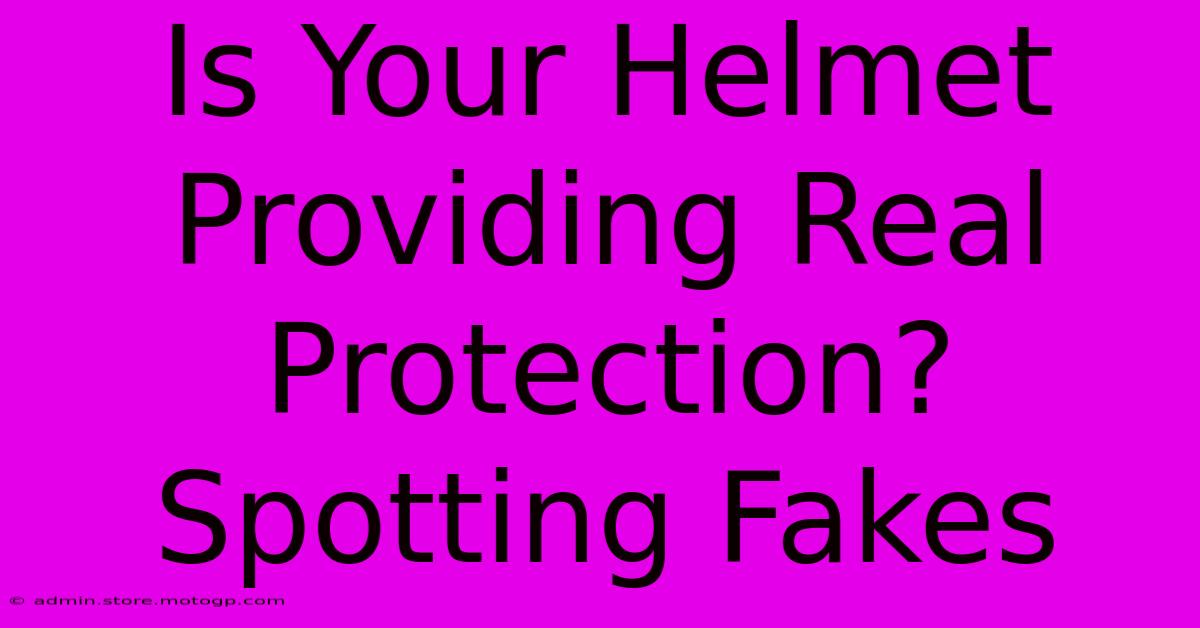Is Your Helmet Providing Real Protection? Spotting Fakes

Table of Contents
Is Your Helmet Providing Real Protection? Spotting Fake Helmets
Your helmet is your first line of defense against serious injury in a fall or accident. But what if that helmet isn't what it seems? The market is flooded with counterfeit helmets, offering the illusion of safety without the real protection. This article will equip you with the knowledge to spot fake helmets and ensure your head is properly protected.
The Dangers of Fake Helmets
Counterfeit helmets are often made with substandard materials, lacking the crucial impact absorption and structural integrity of genuine safety gear. This means that in a crash, a fake helmet might shatter, deform unpredictably, or even fail to protect your head adequately, leading to:
- Severe head injuries: Concussions, skull fractures, and traumatic brain injuries are all significantly more likely with a helmet that doesn't meet safety standards.
- Increased risk of death: The consequences of inadequate head protection can be fatal.
- False sense of security: The biggest danger is the illusion of safety. Relying on a fake helmet can lead to reckless behavior and increased risk-taking.
Identifying a Counterfeit Helmet: Key Indicators
Spotting a fake helmet requires a keen eye and awareness of certain tell-tale signs. Here's a checklist:
1. Price: Is it Too Good to be True?
Significantly lower prices than those of reputable retailers are a major red flag. Legitimate manufacturers have costs associated with research, development, testing, and materials – a suspiciously cheap helmet likely cuts corners.
2. Packaging and Labeling: Examine Carefully
- Poor printing quality: Blurry text, misspellings, and low-resolution images are common in counterfeit products.
- Inconsistent labeling: Discrepancies between the helmet and the packaging (e.g., different model numbers or logos) point towards a fake.
- Missing safety certifications: Look for certifications like DOT (US Department of Transportation), ECE (Economic Commission for Europe), or Snell. Absence of these certifications is a critical warning sign. Make sure the certification marks are clearly visible and not easily rubbed off.
3. The Helmet Itself: A Closer Look
- Poor finish and construction: Examine the helmet's shell for uneven surfaces, rough edges, or inconsistent paint jobs. Look for any signs of cheap plastics or materials.
- Weak straps and buckles: The chin strap is crucial for a secure fit. A flimsy or poorly constructed strap indicates a low-quality product.
- Loose or wobbly components: Check for any movement in the visor or other parts of the helmet. A properly constructed helmet should be sturdy and secure.
- Unusual smell: A strong chemical smell might indicate the use of inferior, potentially harmful materials.
4. Retailer Reputation: Where Did You Buy It?
Avoid purchasing helmets from unofficial sellers, especially those on less reputable online marketplaces. Stick to authorized dealers and reputable retailers specializing in safety equipment.
What to Do if You Suspect a Fake Helmet
If you suspect your helmet is a counterfeit, do not use it. It's better to be safe than sorry. Replace it immediately with a helmet from a trusted source. Reporting the seller to the appropriate authorities can also help protect others from similar risks.
Conclusion: Prioritize Your Safety
A helmet is a critical piece of safety equipment. Investing in a genuine, certified helmet is an investment in your health and well-being. Don't compromise your safety by purchasing a counterfeit; the potential consequences are too significant. By following the tips outlined above, you can significantly reduce your risk of unwittingly using a fake helmet and ensure that your head is properly protected. Remember, your safety is paramount.

Thank you for visiting our website wich cover about Is Your Helmet Providing Real Protection? Spotting Fakes. We hope the information provided has been useful to you. Feel free to contact us if you have any questions or need further assistance. See you next time and dont miss to bookmark.
Featured Posts
-
Cota Merchandise The Perfect Gift For Any Occasion
Feb 20, 2025
-
Moto2 The Pinnacle Of Two Wheel Racing
Feb 20, 2025
-
Lub Si Cota Living A Life Of Purpose
Feb 20, 2025
-
From Dirt To Track Exploring The Diverse World Of Motorcycle Racing
Feb 20, 2025
-
The Sound Of Speed Experience The F1 Concert
Feb 20, 2025
